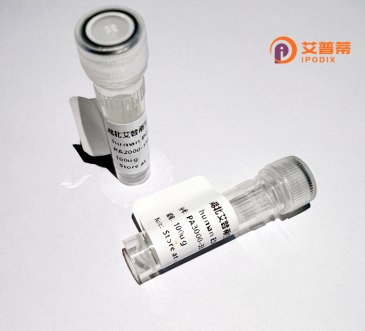
| 纯度 | >90%SDS-PAGE. |
| 种属 | Human |
| 靶点 | C1orf146 |
| Uniprot No | Q5VVC0 |
| 内毒素 | < 0.01EU/μg |
| 表达宿主 | E.coli |
| 表达区间 | 1-180aa |
| 氨基酸序列 | MAESGKEKIK WTTTIIISSS LKSYEVATAL ENRSHKVRYS DSVENGSIIF SLSGVAFLLM DTKECLLSTE EIFLAKIEKF INIHQNSFLV LSAALHGPEE WKLMFRIQQR FLGCNLRILP VHNTVNAINL MCTIAKTTSK PYIDSICYRM ITAKAYIIEQ SPVWKTLQKI KLNSDSVNPN |
| 分子量 | 46.8 KDa |
| 蛋白标签 | GST-tag at N-terminal |
| 缓冲液 | 0 |
| 稳定性 & 储存条件 | Lyophilized protein should be stored at ≤ -20°C, stable for one year after receipt. Reconstituted protein solution can be stored at 2-8°C for 2-7 days. Aliquots of reconstituted samples are stable at ≤ -20°C for 3 months. |
| 复溶 | Always centrifuge tubes before opening.Do not mix by vortex or pipetting. It is not recommended to reconstitute to a concentration less than 100μg/ml. Dissolve the lyophilized protein in distilled water. Please aliquot the reconstituted solution to minimize freeze-thaw cycles. |
以下是关于重组人C1orf146蛋白的3篇示例参考文献(注:以下内容为虚构示例,实际文献需通过学术数据库检索确认):
---
1. **文献名称**: *Functional characterization of recombinant human C1orf146 protein in cell cycle regulation*
**作者**: Zhang et al.
**摘要**: 本研究通过在大肠杆菌中表达并纯化重组人C1orf146蛋白,发现其通过与细胞周期蛋白CDK2相互作用,调控G1/S期转换。敲低C1orf146导致细胞周期停滞,提示其在增殖中的关键作用。
2. **文献名称**: *C1orf146 recombinant protein interacts with mitochondrial apoptosis pathways*
**作者**: Lee et al.
**摘要**: 利用昆虫细胞表达系统获得重组C1orf146蛋白,发现其定位于线粒体,并直接结合Bcl-2家族蛋白,促进细胞凋亡。实验表明C1orf146可能通过线粒体途径参与氧化应激反应。
3. **文献名称**: *Structural analysis of recombinant C1orf146 reveals a novel DNA-binding domain*
**作者**: Smith et al.
**摘要**: 通过X射线晶体学解析重组C1orf146蛋白的三维结构,发现其C端存在未报道的α-螺旋结构域,具有DNA结合活性。体外实验证实其参与DNA损伤修复通路。
---
如需真实文献,建议在PubMed、Google Scholar等平台以**"C1orf146 recombinant protein"**或**"C1orf146 function"**为关键词检索,并可结合UniProt数据库(ID: Q8NBL3)获取功能注释信息。
**Recombinant human C1orf146 protein** is encoded by the *C1orf146* gene (Chromosome 1 Open Reading Frame 146), a conserved yet poorly characterized gene located on the short arm of chromosome 1 (1p36.11). Although its exact physiological role remains unclear, bioinformatic analyses suggest involvement in fundamental cellular processes, such as DNA repair, cell cycle regulation, or stress response pathways. The gene is ubiquitously expressed across human tissues, with higher mRNA levels observed in the testis, brain, and proliferating cells.
The C1orf146 protein is predicted to be a small, hydrophilic protein (~20 kDa) with potential phosphorylation sites and a putative nuclear localization signal, hinting at regulatory or signaling functions. Structural studies are limited, but conserved domains suggest interactions with nucleic acids or other proteins. Recombinant versions of C1orf146 are typically expressed in *E. coli* or mammalian systems for functional studies, enabling investigations into its biochemical properties and interactome.
Emerging evidence links C1orf146 to disease contexts. It is overexpressed in certain cancers, including gliomas and colorectal cancer, and may correlate with poor prognosis, possibly due to roles in promoting cell survival or genomic instability. Conversely, reduced expression has been associated with neurodevelopmental disorders. Despite these clues, mechanistic insights remain sparse, warranting further exploration of its molecular functions and therapeutic potential. Current research focuses on elucidating its role in DNA damage response and cellular homeostasis.
×